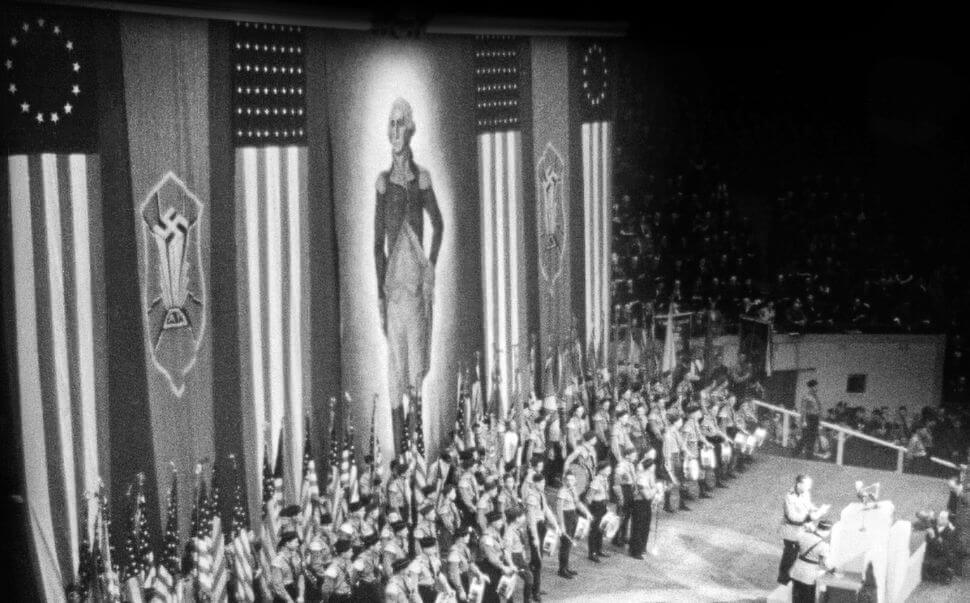Will Trump’s Madison Square Garden rally resemble a fascist one from 1939?
Observers are predicting an event like a well-attended Nazi rally

A scene from the 1939 German-American Bund rally at Madison Square Garden. Image by Marshall Curry Productions/Field of Vision
Donald Trump is making a homecoming to New York, and he’s booked an iconic venue to mark the occasion.
“We just rented Madison Square Garden,” Trump said at a recent rally. “We’re going to make a play for New York.”
Almost immediately this choice of the Garden, the home of the New York Knicks, Rangers and the multi-year residency of Billy Joel, recalled, for some, another rally held at a previous iteration of the arena: the infamous “Pro-American Rally” of Feb. 20, 1939, where red, white and blue bunting hung alongside swastikas.
“Mark this down,” reads a post with over 22,000 likes and more than 1 million views on X. “Trump’s decision to rent out Madison Square Garden is an attempt to recreate the 1939 ‘America First’ Nazi rally. Trump will use this to rally white-supremacist groups as his brown-shirt army to interfere with the election in urban population centers.”
The 1939 rally, held months before Hitler invaded Poland, was not named for or held by the America First Committee, which would not form until the following year, but by the Nazi organization the German American Bund, which would later find common cause with America First’s decidedly un-Germanic brand of isolationism. (The event was held at the old Madison Square Garden on 8th Avenue between 49th and 50th Street.)
Though the rally billed itself as a “mass demonstration for true Americanism,” it was really a cynical ploy by another country, Nazi Germany, to use patriotism to push allegiance to Hitler.
Mark this down. Trump's decision to rent out Madison Square Garden is an attempt to recreate the 1939 "America First" Nazi rally. Trump will use this to rally white-supremacist groups as his brown-shirt army to interfere with the election in urban population centers. pic.twitter.com/Imb6J0BbyZ
— Tea Pain (@TeaPainUSA) October 9, 2024
But, the ethos of the 1939 rally, which married fascist imagery with Americana and was held on the occasion of George Washington’s birthday, nonetheless spoke to a nativism many see in Trump’s MAGA movement.
The day after the rally in 1939, the Forverts ran a special report: “Nazis Hold ‘Americanization’ Meeting With Threats Against Jews.”
A reporter noted how “the Hitlerites were permitted to take advantage of the major American patriot and first president, George Washington, for their own purposes.” The purposes were to slander Jews, malign Franklin Delano Roosevelt (calling him Rosenfeld) and “sing the Nazi anthem just the same as the ‘Star Spangled Banner,’ and to place their swastika flag alongside the American one.”
The Bund, we reported, was in violation of the conditions of the booking manager, who specified there be no “anti-Jewish” banners or speeches. The Bund’s leader, Fritz Julius Kuhn, listed American Jews who “brought trouble to this country,” beginning with Haym Solomon, the financier for the Continental Army.
The rally drew socialist and Trotskyite protesters outside the arena and also attracted Coughlinites, disciples of the antisemitic cleric Father Charles Coughlin’s Christian Front movement.
Even if Trump manages to draw mainstream Republicans to the Garden, there will almost certainly be some on the fringe who choose to attend: groups like the Groypers, Proud Boys and QAnon conspiracy theorists and folks who haven’t been shy about wearing white nationalist merch. If Trump’s rhetoric continues its recent themes, we can expect him to rail against immigrants and asylum seekers and Jews who vote Democratic, all while boasting American values.
But there is a significant distinction between Trump’s event and the Bund’s. Unlike the previous headliner, Fritz Kuhn, Trump, at least on paper, is not an agent of a foreign country — he’s running for president of this one.
















